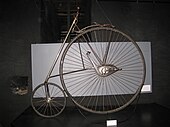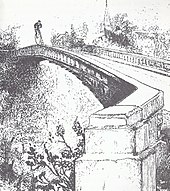Star Bicycle


The Star-Bicycle (also American Star Bicycle) was an American high bike with pedal drive on the rear wheel, which was produced in over 5000 pieces from 1881 to 1887. The Star Bicycle was characterized by a small front wheel and a large rear wheel.
development
The development of this bicycle began as early as 1880 with the US patent from George Washington Pressey dated October 26, 1880 and the US patent from William Klahr dated October 2, 1883. The patent from Pressey was owned by HB Smith Machine Company of Smithville, New Jersey , acquired on January 8, 1881 and built in small numbers as a Star Bicycle. Only through the further development of the model by HB Smith's operations manager, William S. Kelley, and his patent dated July 7, 1885, larger quantities became possible. In addition, there were British patents from PA Maigen (No. 4012) in 1880 and from Kelley (No. 8240) in 1885. In Germany, the two-wheeler was manufactured under license by Kretzschmar & Co in Dresden . However, the Star Bicycle only had economic success in the United States. The triumphant advance of the safety low wheel from John Kemp Starley brought about the end of this production on May 15, 1887.
technology
Driving the Penny Farthing was dangerous, developed so that different inventors safety bicycles. The dreaded head falls were already reduced with the not quite so high kangaroo of 1884, but not completely excluded. The rear-wheel drive offered the better technical option for this. The star front wheel was between 16 and 20 inches (41 to 51 centimeters) in diameter and the rear wheel was between 52 and 56 inches (132 to 142 centimeters) in diameter. Later a model was presented under the name "New Star" with a 24-inch front wheel and 39-inch rear wheel, and in 1891 a model with pneumatic tires.
The drive worked via two swing pedals on freewheels with pawls on the rear wheel. Return springs pulled the pedals back to their original position. The vibrating pedals could be operated independently of each other. By pressing the button at the same time, a stronger acceleration could be achieved, which was used for example in bicycle races. The connection to the freewheel could be hung in two positions, creating a kind of gear shift. To ensure the safety demonstrate the bicycle, spectacular rides, including the steps of were the Capitol in Washington down and on a bridge wall, performed. The advantages of the drive and the safety aspect could hardly compensate for the disadvantages of the easy steering reaction.
The artificial cyclist Nick Kaufmann used a star bicycle for his acrobatic tricks and in 1883 accidentally invented the sport of cycling with it .
"One day [...] a small dog ran in front of my bike. I quickly lifted the front wheel and pushed the pug out of the way as gently as possible - saving me from a fall, the animal from injuries."
This gave rise to the idea of taking a ball. On September 14, 1883, Kaufmann demonstrated this game for the first time with another artificial cyclist. In his early days as a cyclist, Arthur Augustus Zimmerman competed in races with the Star Bicycle.
As early as 1885, Lucius D. Copeland developed a steam bike from the Star Bicycle , which he produced in around 200 copies.
Web links
literature
- Wiebe E. Bijker: Of Bicycles, Bakelites, and Bulbs. Cambridge, Massachusetts Institute of Technology , 1995, ISBN 978-0-262-02376-4 .
- Wolfgang Gronen, Walter Lemke: History of cycling. Fuchs-Druck und Verlag, Hausham 1987.
- Max JB Rauck, Gerd Volke, Felix R. Paturi: By bike through two centuries. The bicycle and its history. 4th edition. AT Verlag, Aarau u. a. 1988, ISBN 3-85502-038-8 .
- Andrew Ritchie: King of the Road. Wildwood House, London 1975, ISBN 0-913668-42-7 .
- Carey Williams: American wheels to the front. An Insider's view of the Star Bicyle. 20th International Cycling History Conference , 2009, 219-226.
- Wilhelm Wolf: Bicycle and Cyclist. Leipzig, 1890, Dortmund (3rd reprint), 1988
Individual evidence
- ↑ a b c Wolfgang Gronen, Walter Lemke, p. 67.
- ↑ Andrew Ritchie, p. 128.
- ^ A b Carey Williams, p. 225.
- ↑ U.S. Patent 233640
- ↑ U.S. Patent 285821
- ↑ U.S. Patent 321932
- ^ Wiebe E. Bijker, p. 297.
- ↑ bicycles. In: Polytechnisches Journal . 299, 1896, pp. 172-179.
- ↑ a b Max JB Rauck, p. 67
- ↑ a b c Wiebe E. Bijker, p. 68.
- ^ Wilhelm Wolf, p. 114.
- ↑ The New Star (accessed August 25, 2017)
- ↑ Smith Pony Star bicycle (accessed August 25, 2017)
- ↑ Nick Kaufmann. See [1]
- ↑ cycleballer.com Radball (accessed on August 24, 2017)
- ^ Christian Rey and Harry Louis: Famous Motorcycles. Heyne Verlag Munich, ISBN 3-453-52062-9 , p. 8.


